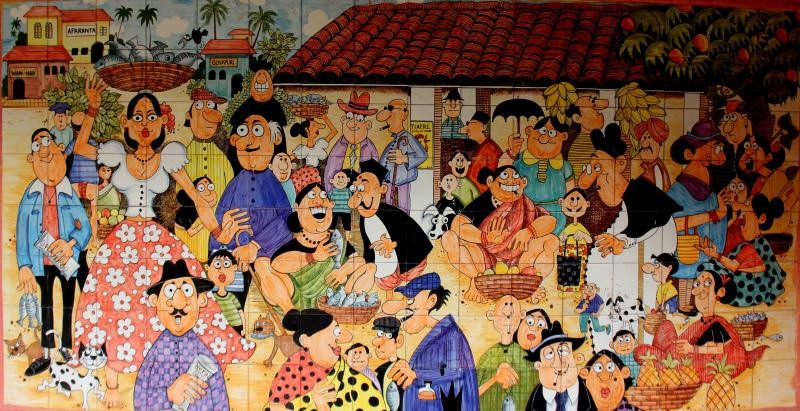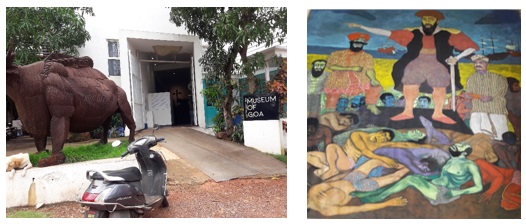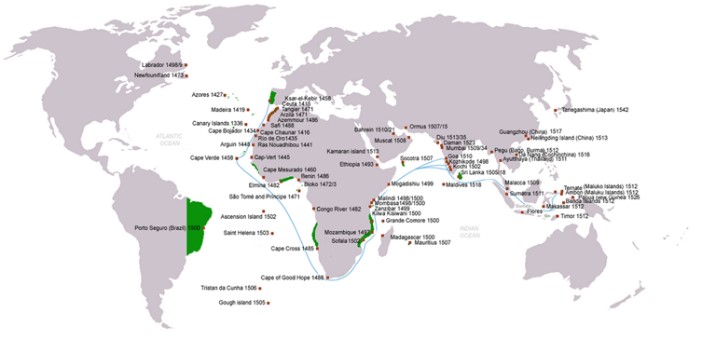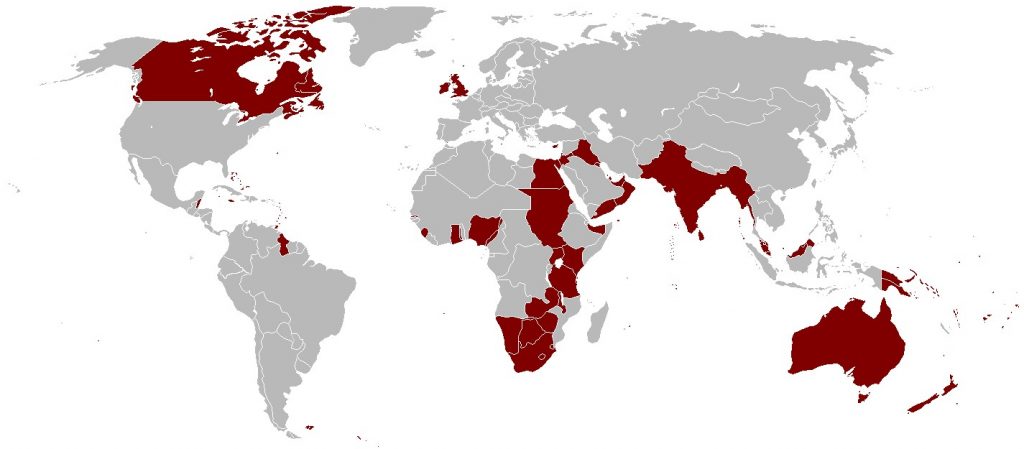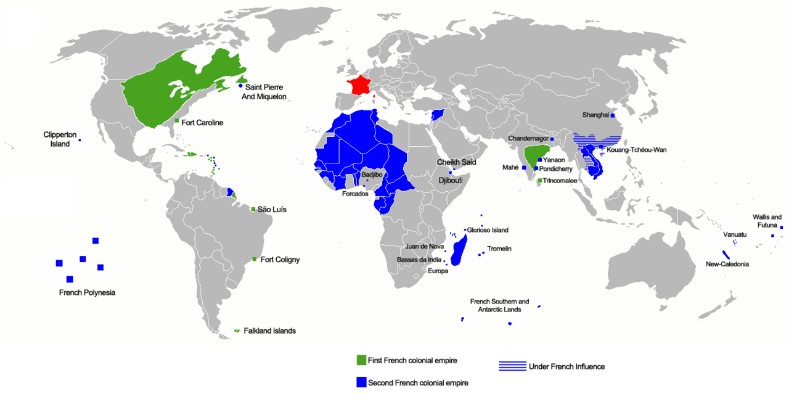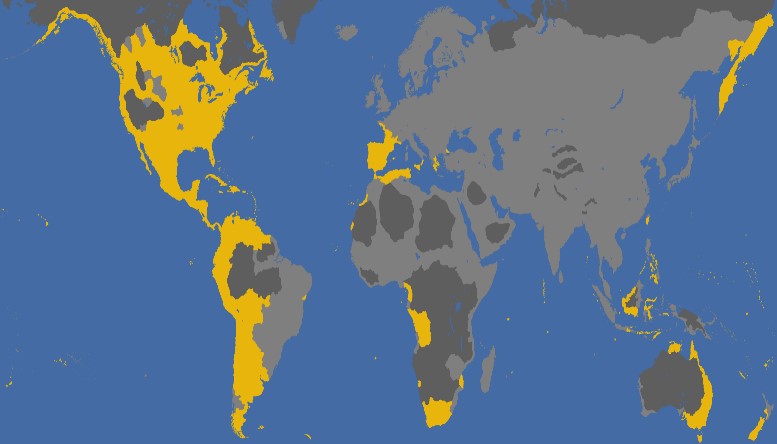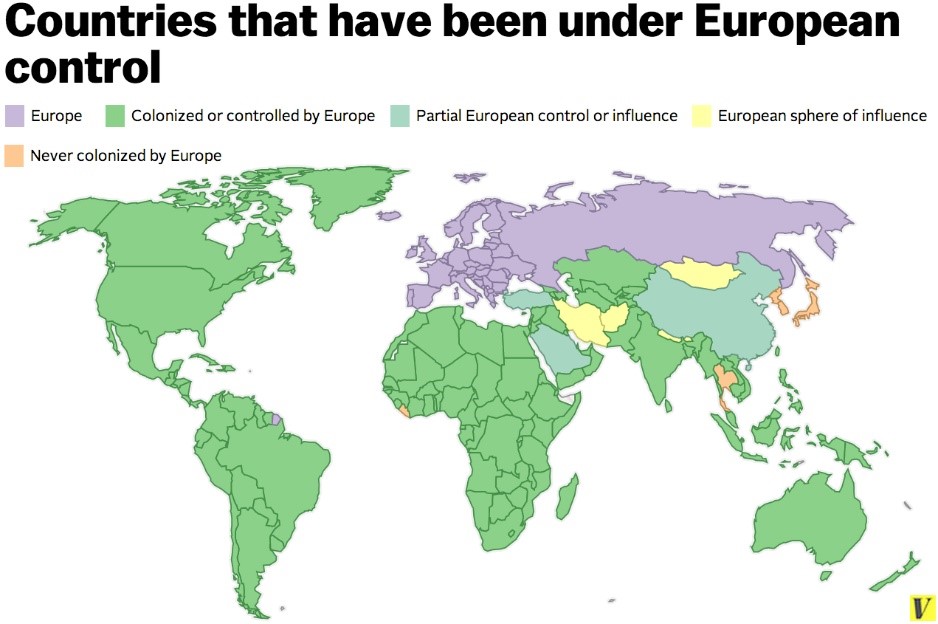Goa is magical; and more so in the monsoon months when we first visited. The smallest state in the country with the highest per capita income is a jewel in the crown of Indian tourism. For many foreign nationals, India means Goa. The pristine beaches, the wildlife sanctuaries, the waterfalls, and the friendly nature of people makes it one of the most repeatedly visited destinations.
The friendly Christian guide, on the way to Arvalem caves, declared proudly that there is no religious strife in Goa as all religions are equal; and warmly told that Goa is the only state where there is a uniform civil code. That certainly warmed my heart as I quickly googled to double-check. Arvalem caves, traced to about 6th or 7th century BCE, are rock-cut structures into laterite stone; and are either Hindu or Buddhist in origin. There is a beautiful and small Shiva temple in the vicinity along with a waterfall, and the place is worth visiting. The Arvalem caves are also known popularly as ‘Pandava Caves’. One can see Pandava caves and Pandava steps anywhere in the country! Michel Danino significantly says in his book, ‘India’s Culture and India’s Future’:
The greatest cultural point of India is its unity in diversity. A dense network of holy places and temples created a sacred geography of the country and a strong tradition of pilgrimages in the country. The 12 Jyotirlingas, the 52 Shakti Mahapithas, and the 26 Upapithas spread over India, Nepal, Bangladesh, and Pakistan became the defining point to draw the boundaries of the country. The cultural integration began in the Harappan times and accelerated during the Gangetic civilization phase in about 700 BC. It was an organic process and not controlled by any authority, caste, or power. It is not the Vedas or the Upanishads which were the uniting force, but the two great epics- Ramayana, and Mahabharata. These epics became the major tools for integration. The references to the great epics, found all over the country and even places like Indonesia, show local traditions linked in some way to the two great epics. The greatness of this integration is in the fact that it did not stamp out any local cultures, unlike the other cultures, which was more of a conquering type. Hinduism’s definition is the interface between Vedic and regional folk and tribal cultures. In the words of Tagore, ‘India has been always trying to evolve a social unity in which different people hold together, while fully enjoying the freedom to maintain their own differences. This has produced a United States of social federation; whose common name is Hinduism”.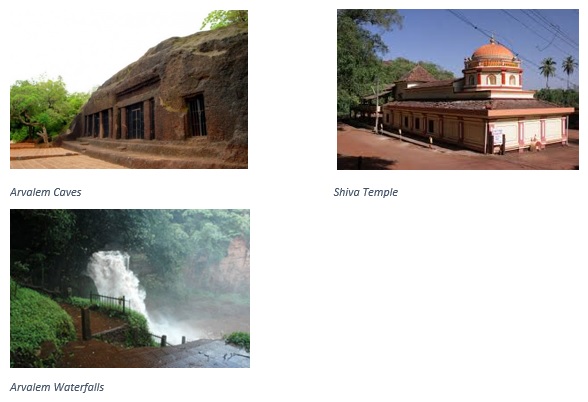
Mario Miranda is undoubtedly one of the most famous cartoonists of India; and he hails from Goa. There are plenty of galleries dedicated to him. A franchise has evolved selling his works of art and cartoons on different mediums. A visitor to Goa cannot leave the place without visiting one of the galleries and spend a few hours at least. I could challenge anyone to leave the store without buying anything.
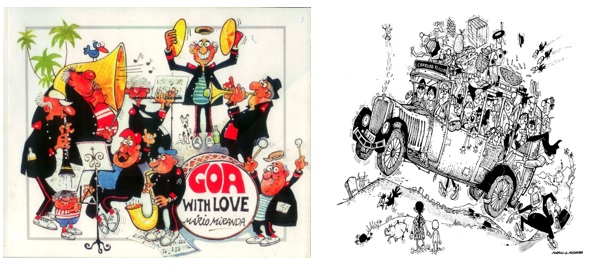 Two-wheelers on hire is a popular method of exploring Goa, its history, heritage, forts, and temples. They are available for 300-400 rupees a day and it was great fun doing just that in the rains with raincoats on! The natural beauty of Goa is astounding, to say the least. There are no snakes in Ireland; and there are no petrol pumps in Goa. Wherever we asked for a petrol station, it was always a good 3 kilometres away. It was sad to see an on-the-face illegal selling of petrol in most bike-hiring points and even in grocery stores! Petrol sells in 1 litre bottles at a hiked price of 90 or 100 Rupees! I am sure everyone is highly aware of this blot on the tourist golden place, and the government surprisingly is not taking steps enough. The broken and shattered roads again are no different from most of the country (irrespective of the political party), mirroring a corrupt state of governance. Unfortunately, heavy monsoons disallowed us a visit to the famous Dudhsagar falls, claimed to be one of the most beautiful in the country.
Two-wheelers on hire is a popular method of exploring Goa, its history, heritage, forts, and temples. They are available for 300-400 rupees a day and it was great fun doing just that in the rains with raincoats on! The natural beauty of Goa is astounding, to say the least. There are no snakes in Ireland; and there are no petrol pumps in Goa. Wherever we asked for a petrol station, it was always a good 3 kilometres away. It was sad to see an on-the-face illegal selling of petrol in most bike-hiring points and even in grocery stores! Petrol sells in 1 litre bottles at a hiked price of 90 or 100 Rupees! I am sure everyone is highly aware of this blot on the tourist golden place, and the government surprisingly is not taking steps enough. The broken and shattered roads again are no different from most of the country (irrespective of the political party), mirroring a corrupt state of governance. Unfortunately, heavy monsoons disallowed us a visit to the famous Dudhsagar falls, claimed to be one of the most beautiful in the country.
There were limited water adventure sports, being monsoon, but we could enjoy a short cruise in the rains. The waters and the dark monsoon clouds meeting in the horizon was a sight etched permanently into our memories. Twice a day, the sea in its various moods was a source of deep contemplation and a silent thrill.
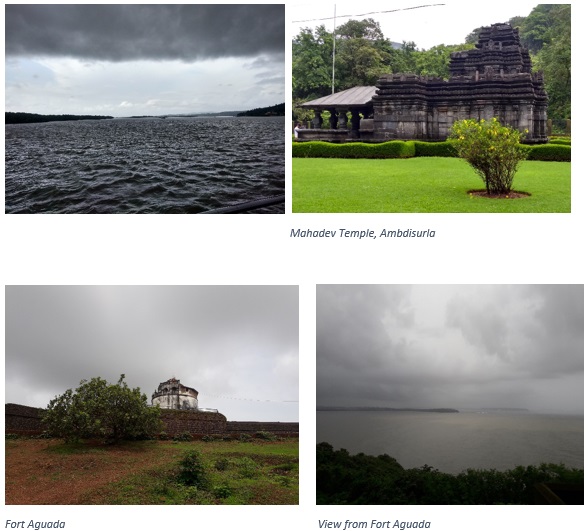 The Russians are particularly fond of Goa. In non-monsoon seasons, especially during Christmas, they flock to Goa in vast numbers. To the extent that many signboards and hotel library books are in Russian! I would like to believe that the special fondness of Russia is because of the special bondage and love for us. Russia was the only country to support India during the stiff resistance offered by Portugal in NATO assembly to evacuate Indian territory. The local citizens tell that Goa is a much cheaper tourist destination than other places to escape the Russian winters, a more plausible explanation.
The Russians are particularly fond of Goa. In non-monsoon seasons, especially during Christmas, they flock to Goa in vast numbers. To the extent that many signboards and hotel library books are in Russian! I would like to believe that the special fondness of Russia is because of the special bondage and love for us. Russia was the only country to support India during the stiff resistance offered by Portugal in NATO assembly to evacuate Indian territory. The local citizens tell that Goa is a much cheaper tourist destination than other places to escape the Russian winters, a more plausible explanation.
A tourist used to Uber and Ola might feel a bit handicapped in Goa. They do not ply in Goa due to strong resistance by the local bodies. This makes one depend on the local means of transport with a typical non-linear availability and an erratic fare structure. However, that is a minor irritant. Goa has an excellent pilot service where there are drivers on two-wheelers zipping you to any place.
The drink, eat, and fun driven tourism is indeed sad because Goa is much more than that. Its history, arts, culture, language, architecture, temples, churches, flora, fauna, wildlife, waterbodies, and scenic beauty is amazing, and one can spend many days absorbing just one aspect of Goa. Desperate tourists looking only to drink themselves crazy and enjoy on the beaches have sadly overridden all of these. Goa has one of the most tortured histories mostly unknown to Indians and rarely described in the textbooks. Very few would be even aware that the Portuguese ruled Goa for a continuous period of 450 years.
Conquest of Goa
A small war-mongering country, Portugal, sent Vasco da Gama to discover a route to India, who in 1498, landed in Calicut first and later started the colonial story of Goa. Portuguese admiral Alfonso de Albuquerque attacked Goa at the behest of the local chieftain Thimayya in 1510. Initially he lost, but later Albuquerque came back with a full fleet to win decisively Goa from Adil Shah, the Muslim king of Bijapur. 6000 of the 9000 Muslim defenders died during this battle with Albuquerque. The Hindu population was initially supportive of this; however, Thimayya became a chief administrator while he dreamt of total control of that area.
Goa gradually became the center of Portuguese India. Albuquerque started the first Portuguese mint in Goa for the East and used it as an opportunity to announce the territorial conquest by the design of the new coins bearing a cross on one side and King Manuel’s badge, on the reverse. Goa was the base for Albuquerque’s conquest of Malacca (Malaysia) in 1511 and Hormuz (Persian Gulf) in 1515. Malacca and Hormuz are extremely strategic points; and the intelligence of these sea-faring nations always looked for these crucial points of control.
Goa became the capital of the Portuguese possessions in India, Malacca, Indonesia, East Timor (the part received by the Portuguese in its fight with the Dutch who got the western part), and the Persian Gulf. Macau in China and trade bases in Japan were also under the suzerainty of the Portuguese Empire, but Goa did not rule them. The Portuguese gave up Macau as recently as 1999. East Timor gained independence in 1975 from the Portuguese rule when Indonesia took over. East Timor has a tortured history of its own.
The Portuguese rule tried at imbuing the people with a loyalty to Portugal, through the process referred to as Lusitanisation. This was different to the Macaulaycan endeavor to create a class of people who were British in their ‘manners, morals and intellect’. The attempt was to create a micro Portugal on Indian territory, through a process of official nationalism.
From the beginning of its colonization of Goa, the Portuguese looked at the church as an agency through which it could strengthen its hold over its colony. The Padroado system formalized the alliance of the crown and the church, where the king of Portugal had all ecclesiastical powers. ‘To Christianise is to make Portuguese’ was the governing attitude of the Portuguese during a majority part of their rule till 1910. In 1736, an edict tried to transform even the basic food and dress habits of the people. There was a ban on the singing of traditional folk songs and keeping sacred tulasi at homes. Christians could not keep Hindus names or surnames.
16th Century – Strengthening of Hold
By mid–16th century, the Portuguese quickly got a firm hold over Goa, which had the same civic privileges as Lisbon. Its senate or municipal chamber kept direct communications with the king through an official representative. In 1563, the governor proposed to make Goa the seat of a parliament standing for all parts of the Portuguese east, but the King rejected the proposal. This happened only as late as 1757. The Portuguese used Goa to strengthen their control of the lucrative spice trade. The markets of Goa were famous for the Eastern products like spices, porcelain, silk, and herbal drugs. Slave trade became common as the exploitation of the people became prominent.
1556 was a landmark era which saw the introduction of the printing press into India at Goa. The printing press was a tool which the Portuguese Jesuits used extremely effectively in their educational and evangelizing missions. The administrators used the same to spread European culture, customs, and thought to the ruled parts of their world. The Portuguese were the first to introduce this powerful technology into Macau and Japan by the latter half of the 16th century.
The Jesuit priests had a key role to play in this promotion of education, research, culture, and finally evangelization. The missionary zeal was the defining aspect of the Jesuit priests starting with St. Francis Xavier (1506-1552) who first set up a seminary called Saint Paul’s College. He was a companion of Saint Ignatius of Loyola and a co-founder of the Society of Jesus. Others like Antonio de Andrade, Saint Joseph Vaz, and Angelo de Souza followed to set up strong educational institutes and churches in distant places as far as Delhi, Tibet, Sri Lanka, China, and Japan.
Around 1583, missionary activity in Cuncolim led to conflicts, culminating in a revolution where natives killed all the missionaries. The Portuguese authorities called the sixteen chieftains of each ward to Assolna Fort to form a peace pact with the villagers. At the fort, the Portuguese killed the chieftains, except for two who jumped from the fort into the Arabian Sea and swam to safety. The villagers lost their traditional leaders and the Portuguese began confiscating the land of the locals.
The Goa Inquisition – Shameful Period from 1560 to 1812
The infamous Goa Inquisition was the office of the Inquisition acting within the Indian state of Goa and the rest of the Portuguese empire in Asia. Francis Xavier requested initially the court to be set up, but it started in 1560, eight years after his death. Marquis de Pombal (1750-1778), trying to bring some liberal changes, briefly suppressed the office of Inquisition from 1774–1778. The abolishment was finally in 1812.
The Goa Inquisition is an uncomfortable chapter in the history of Roman Catholic Christianity- even devout Catholics agree to this. Based on the records that survive (many deliberately destroyed when the office closed), the Inquisition tried 16,202 persons. 57 got the death punishment; and 64 burnt in effigy. The others got lesser punishments or penances. The Inquisition was set up to punish the new Catholic converts – Jews, Hindus, and Muslims- suspected of practicing their ancestral religion in secret. Numerous Portuguese Jews (as converted Catholics) had come to Goa and worked as traders. Due to persecution during the Inquisition, most left and migrated to Madras and Cochin, where English and Dutch rule, respectively, were more tolerant. It also prosecuted non-converts who broke prohibitions against the observance of Hindu or Muslim rites or interfered with Portuguese attempts at conversion.
While its claimed goal was to preserve the Catholic faith, the Inquisition was against Indians of all religions, including Catholics, as an instrument of social control, and to gain money from confiscation of properties and seizure of wealth. It was a brutal institution and even the Viceroy was powerless against its influences. But the administrative powers were silent as the Inquisition helped in keeping the citizens quiet and scared. The brutal chapter of the Inquisition is something we are completely unaware of. The history books obliterated this chapter in the name of secularism; however, the fact is that Catholics too have condemned the Inquisition done in the name of Christ.
Temples dot Goa whose history is that of secret transfers of the main deity from temples destroyed by the Inquisition in the fertile Old Conquest areas (now coastal talukas of Tiswad, Salcete and Bardez). Shefali Vaidya in her talk, ‘Goa Inquisition: Lest we forget’ describes this tragic story well. Many temples in Goa are in the New Conquest areas, which came into Portuguese possession a good 270 years after the European power acquired its first foothold in Goa in 1510. The New Conquests are a group of seven administrative districts of mainland Goa added onto Goa in the 18th century. The enclaves of Goa, Daman, Diu, Dadra-Nagar Haveli became the Estado da Índia Portuguesa, and had representation in the Portuguese parliament.
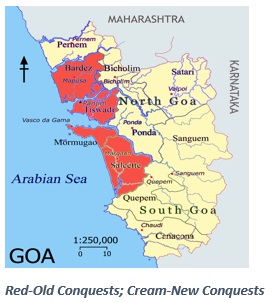 There is a fantastic Museum of Goa started by artist Subodh Kerkar which captures well the painful history of Goa. It is highly recommended for a visitor to Goa. One of the art works informs that in 1560, on a single day, over 1500 Hindus converted to Christianity.
There is a fantastic Museum of Goa started by artist Subodh Kerkar which captures well the painful history of Goa. It is highly recommended for a visitor to Goa. One of the art works informs that in 1560, on a single day, over 1500 Hindus converted to Christianity.
European Wars and Indian Battles for Goa
It is important to realize how the pirate sea-faring nations like England, Portugal, Spain, France, Netherlands, Denmark, and Belgium around the Celtic Sea, English Channel and the North Seas played havoc with the world in their greed for money and power. The impact of these conquests is still echoing in the present-day times. Even a country like Belgium which thankfully did not look at Asia had a horrific and violent history of colonisation in Congo. The other European countries not bordering the sea have been guilty of dragging the world into its wars of greed and ambition. Indeed, the Europeans have had a very brutal history in upsetting the world order where the governments combined with private bodies; and got moral and other justifications from the Church and the Universities. Unfortunately, they have also been the history writers. When they indulged in an abnormal rule in a foreign land of foreign cultures, the ruled came depicted as primitive and pagan (colonial literature on India for example); when someone whipped them, like a Genghis Khan, the aggressors became satanical and monstrous. It is good to control the narrative.
Netherlands, England, France, and Portugal were always fighting for Asian lands as if it was their fiefdom, and the story of Goa is no different. The Dutch (Netherlands) tried to capture Goa in the early part of the 17th century but were unsuccessful in their attempts. They set their colonies around Cochin. The English occupied Goa peacefully between 1812-1815 in line with the Anglo-Portuguese Alliance during the Napoleonic Wars. There is a wonderful narration of the Dutch, English, Portuguese, and French wars on the Indian coast by Sanjeev Sanyal in his book, ‘The Ocean of Churn’. It is a hugely recommended fare for anyone interested in the history of sea bound land of India.
Portugal took a neutral stance in the second World War and hence, Goa remained neutral too. There are some sub-stories of this war too. Some German ships took refuge in Goan waters and started sending messages about Allied ships to the Axis forces. The British conducted a secret raid using civilian ships to sink one of the German ships and scare the rest of the ships to hurry out.
European Havoc on the World Order – Some Maps
French Empire at its peak
Ending of Monarchy in Portugal – Hope and Disappointment
Marquis de Pombal (1750-1778) tried to bring some liberal changes in religious and racial discrimination, but they were short lived. Monarchy ended in 1910 in Portugal and the new Republic quickly separated the Church from the State. There were radical changes in the colonies too. In Goa, for the first time under Portuguese rule, religious freedom and equality allowed Hindus parity with all citizens. The temples could function freely, and the Hindus could avail education legitimately.
However, there were unfortunately 24 revolutions and coups resulting in 43 cabinets and nine presidents in the 16-year span of the Republic. In 1930, Dr Antonio de Oliveira Salazar, initially appointed as minister of finance, rose to the rank of premier. To stem the grave political and social unrest in the country, Salazar initiated a host of repressive measures in Portugal and in the colonies. Once again racial discrimination became legitimate in the colonies. There was withdrawal of the right to vote and parliamentary representation. The Portuguese state once again continued the process of official nationalism, insisting that Goa was an extension of Portugal. On 21 October 1930, the Acto Colonial denied the right to self-determination to the colonies, which became ‘overseas provinces’.
Somehow, despite all efforts, Goa could not gain independence within the framework of Indian independence movement though Gandhi tried to unite all political factions in Goa under one common umbrella. Post-independence, mixed and confused signals from the Delhi leadership, busy with their own problems of a new India including wars with Pakistan, did not allow an early amalgamation of Goa into India. They soft-pedalled the issue for some time. Diplomatic efforts also failed as Portugal took a route of resistance unlike the French who gave up their territories relatively easily.
Economics of Portuguese Rule
The economics are hard to understand considering the extent of Portuguese empire and the exploitation of its colonies all over the world, including a thriving slave trade. Unlike the British who became strong by its imperialistic exploitation, Portugal remained a poor country. Portugal was a ‘pioneer in expansionism’, motivating other sea faring, ship building neighbours to explore, conquer, loot and plunder. However, it became a satellite of Britain through various treaties. It was and continues to be one of the backward countries in western Europe in terms of GDP and per capita income. The first steam engine introduced in Britain in 1776 did not show its presence in Portugal for another 60 years. This is mainly due to short-sighted Portuguese economic policies when it failed to outgrow its initial mercantile objectives of extracting maximum profits with minimal investment.
Agriculture, mining (despite knowledge of rich deposits of copper, gold, and iron), infrastructure, industry and higher education stayed quite static as Portugal did not make any great attempts at its boosting. Trade, commerce, tariffs, and other dues remained its major source of revenue. Interestingly, the only major infrastructural developments of the railway and Mormugoa harbour was by the British at the request of the Portuguese in around 1880. Portuguese Government was content with the payment of five to six per cent returns on the capital invested in the above projects. They were happy with tariffs they received on all exports made, despite poor investment in production. Lotteries and excise duty also generated an income for the government. In 1939, around 20-25% of total income consisted of excise tariffs, second to customs as the greatest source of state revenues. Portuguese India hence gained the dubious distinction of being the ‘most intoxicated’ country in the world.
There are hints of silent encouragement of smuggling and illegal sales of Indian goods to generate the much-needed Indian currency, as Portuguese currency was not popular for foreign exchange! Prior to liberation, only two irrigation canals were in existence. The initiative to export cash crops such as coconuts, cashew nuts, supari (areca nut) and fruits remained with the locals. Prodosh Aich in his book, ‘Truths’ is very brutal in assessing the Portuguese. He simply calls them looters and plunderers as they were never ‘traders’ because they had nothing of their own to trade!
Banco Nacional Ultamarino, the only bank, was responsible for the circulation of currency in Goa. This bank had the dubious distinction of accepting deposits but offering no interest and advancing loans at what was probably the highest rate of interest in the world.
Strangely, the people had Goa had a higher standard of living as compared to rest of India with lower costs of living. This was a reason for the reticence of the local Goans to wage a revolution and unite with the rest of the country in fear of higher costs. Goa still has the highest per capita income in the country amongst all the states. Portugal was poor, remains poor; Goa was rich, and remains prosperous. And Portugal only exploited by way of tariffs and taxes. The reason could be that Indian economy was strong on its own, only Portugal did not know how to exploit it the way the Britishers could. The British could rip apart the country more effectively in the 200 years of its presence. Amazingly, there are voices who claim that 200 years is a myth; it is more aptly 100 years of conquest and 100 years of rule. 200 years is a myth to promote nationalism based on false history!
Education under Portuguese Rule
In the initial part of Portuguese rule, the missionaries focussed on education, but later it was a downward spiral, especially for the Hindus. There was large scale migration of Goans for higher education and employment to Bombay, Karachi, and other colonies as agriculture and employment stayed weak. Prior to 1910, Hindus had no right to receive education from government institutions; and teaching was a purely Christian profession. The government, missionary organizations and private individuals ran schools in Portuguese, English, and Marathi mediums, respectively.
The New Conquests, which made up 80 per cent of Goa, had poor educational facilities. In 1869-70 there were 112 primary schools, of which only 16 were in the New Conquests. On the eve of liberation, out of 146 official primary schools, 103 were in Old Conquest areas and only 43 in New Conquest areas. In 1910 total literacy was 13.1 per cent. In the Old Conquest talukas, the lowest level of literacy recorded (12.85 per cent) was higher than the highest percentage of literacy recorded in the New Conquest Goa (11.65 per cent).
A mixture of four languages pervaded the educational and social life: Konkani, Marathi, English, and Portuguese. Theodore Mazarello, Secretary of the Goan Students Association, Bombay, wrote in 1957:
I think nowhere in the world does the Portuguese system of education as perpetrated in Goa find a parallel. It is nothing but indoctrination. The student is taught nothing about the outside world. Portugal is glorified as a nation that has produced the world’s only explorers. Nothing is taught either of America or England, leave alone India. In spite of strict regimentation of thought, the Goan students studying in Goa itself have managed to learn a lot about India. The limited success of the lusitanisation endeavor is reflected in the fact that on the eve of Goa’s independence only two per cent of its population spoke Portuguese and was literate in it. Konkani remained the spoken language for the overwhelming majority of the people, but people were literate in Portuguese, Marathi or English, depending on whether they were educated in schools run by the government, private bodies or missionaries. In spite of Konkani being the mother tongue of most Goans, a section of Hindus views it as the language of the Christians and have chosen to identify Marathi as their language.
Social and Political Life
Religious identity and caste consciousness marked the social and political life heavily, though the Portuguese tried to eliminate that by various means possible. The Lusitanised Goans with complete loyalty to Portugal were small, but they formed an articulate and vocal group against uniting with India. Though Goa is supposed to indicate communal harmony, especially after 1910, it was not a completely true picture.
The distinguishing features of social life in Goa were: a large-scale migration to other parts of India and abroad; a peculiar phenomenon of the languages of literacy being different from the spoken language of the people; people divided by religion; and a deep caste consciousness. Goa has the fifth highest percentage of Christians in the country. However, contrary to widespread belief, Goa is not a predominantly Christian state. In 1981, Hindus comprised 64.20 per cent of the population and Christians 31.25 per cent, most of the rest being Muslims.
In the last century, the Christian population was in the majority, comprising two-thirds of the population. Exodus of Hindus from Goa between the sixteenth and eighteenth centuries and large-scale conversions were responsible for this. The change in this pattern took place in the post liberation years, beginning with the establishment of the republic in Portugal. The concentration of Christians is greater in the Old Conquests than in the New Conquests. Despite the population division into Hindus and Christians, amazingly Goa has no history of communal riots. It is no wonder projected as an isle of communal harmony.
Unfortunately, even in recent times, theologists like Fr. Victor Ferrao from the influential Roman Catholic Church claimed that ‘Hindus’ did not exist in region during the pre-Portuguese era in attempt to confuse and obfuscate. He uses the commonest argument in the book related to paganism by stating that ‘the temples demolished by the Portuguese colonists from 15th century onwards were not Hindu temples, but instead belonged to different independent cults and religions which were often at war with each other’. He charges Hindus of a ‘reductionist and distortionist’ appropriation of Goa’s history and with a direct attempt to turn historical facts about conversion against the Church and the Christians of today. It certainly is a bold attempt and has few takers even amongst the Christians of Goa.
Temples of Goa
The Muslim and Christian influences certainly made its impact on the unique architectural style of the temples, which look quite different from the rest of the country. As a professor of art history says, ‘Goa’s New Conquest temples are different from most Hindu structures elsewhere in India by their emulation of Western spatial divisions and their use of a European architectural vocabulary’.
The domed roofs are a Muslim trait, while the white washed octagonal towers and balustrade facades have influences from Portuguese Church architecture. A unique feature of Goan temples is the ‘deepastambhas’ or the lamp towers a few storeys high, an influence from the Maratha temple traditions. The curvilinear roofs of the mandapas is another Portuguese influence. A unique Indo-Christian style of architecture is wonderful, to say the least. Though the external elevations strike visibly different for a first-time visitor, they are extremely beautiful and charming. The temples of Goa add to the immense diversity of the temple architecture of our land.
Goa Liberation
There was a constant needling on the Portuguese from different sides including plague, foreign nations, and locals like the Marathas. In 1683, Sambhaji, son of Shivaji, almost ousted the Portuguese, but in a classical act of an enemy’s enemy being a friend, the Mughals helped the Portuguese in repelling the attack. Shivaji also conquered some of the Portuguese Goa.
Anyway, the Portuguese discriminated against the local people. There were 14 revolts against Portuguese rule starting as early as 1787 when some priests started a rebellion which has been name the ‘Conspiracy of the Pintos’. The local population including many Catholics were hugely disgruntled by the discriminative policies of the Portuguese against them. Surprisingly, the Portuguese was able to fend off all the attacks to set a four and a half century of continued rule.
The Goa liberation movement started as small scale revolts of the 19th century and grew powerful during the period 1940-1961. The movement conducted both inside and outside Goa included satyagraha, armed revolution, and diplomatic efforts. The Portuguese refused to let go of Goa even after Indian independence as was its stance in most of its colonies around the world. It invoked NATO too for its help. Although the NATO treaty did not cover colonies, Portugal insisted that its overseas interests were not colonies but an integral part of the Nation of Portugal. Their equations and arguments completely and shamelessly ignored the history of the people and land before their invasion!
The Goa Liberation Army, founded by Shivajirao Desai, an Indian army officer in the 1950s, used revolutionary direct-action tactics to challenge Portuguese colonialism. It blasted many mines and conducted raids; and played a crucial role in defending the bridges at the time of Indian invasion. In the meantime, the Satyagrahis also became quite vocal and effective in creating a conscience against the foreign rule. The Portuguese government charged India with violation of Portugal’s territorial sovereignty due to Satyagrahis crossing Portuguese Goan borders. Nehru under diplomatic pressure declared formally that India disapproved; and this severely impacted the independence movement for some time.
Many locals like Menezes Bragança, AG Tendulkar, Dr Juliao Menezes, Dr de Mello with support of people like Ram Manohar Lohia were important forces against the colonial rule. Azad Gomantak Dal, founded by Lawande Hari naik and others, used direct action revolutionary strategies. They carried a series of attacks against the government.
However, the Portuguese Catholic Church strongly supported pro-colonial policies and attempted to influence Goan Christians to oppose the independence movement. The Portuguese Patriarch of the Catholic Church in Goa issued over 60 official letters to the priests of the archdiocese, instructing them to preach to their congregations that salvation lay with the Portuguese and in dissociating themselves from cultural-political relationship with the rest of India.
1954 is another landmark year. On 18 June 1954, Satyagrahis infiltrated Goa and hoisted the Indian flag. The government authorities arrested the demonstrators. Anti-colonialist activists Dr. Gaitonde and Shriyut Deshpande had deportment to Portugal. In July 1954, the United Front of Goans (led by Francis Mascarenhas) forced the Portuguese to retreat from the colonial enclave of Dadra. A group of volunteers from the National Movement Liberation Organisation (NMLO), an umbrella organisation involving revolutionary groups Rashtriya Swayamsevak Sangh and Azad Gomantak Dal, led an attack on Nagar Haveli later, and took it on 2 August.
Despite successfully conquering the territories, India did not immediately assimilate these enclaves into the Indian Union. For some time, both enclaves functioned as independent states, administered by the Varishta Panchayat of Free Dadra and Nagar Haveli.
The Final Push
The Portuguese responded to the Satyagrahas by sealing Goa’s borders. By 1955, the Indian government developed a clear policy on supporting the anti-colonial movement. Between 1955 and 1961, six political parties formed to advocate an end to Portuguese colonial rule. These parties were Azad Gomantak Dal, Rancour Patriota, the United Front of Goans, Goan People’s Party, Goa Liberation Army and Quit Goa Organisation
In 1961, India declared that Goa should join India ‘either with full peace or with full use of force’. In August 1961, India began military preparations; and, on 1 December 1961, Indian troops stationed close to the Goan border. Operation Vijay conducted on December 18 and 19, 1961 finally assimilated Goa into India. The Portuguese surrendered with little resistance ending its phenomenal rule.
Goa and Daman-Diu became Union Territories. Dadra and Nagar Haveli, which was previously a part of the Estado da India, but independent between 1954 and 1961, became a separate Union Territory. Goa became a full state of India in 1987.
Concluding Thoughts
This is a whirlwind history of the wonderful land of Goa. People from all over the country come to Goa in all seasons. Fun, adventure, sports, wildlife, and the scenery are the major motivations. Unfortunately, sanitised, edited, and politically correct histories taught in schools does not help the tourist in getting a correct perspective of the land.
Thankfully, a tortured history has still allowed the land and its people to integrate into India seamlessly without any ill feelings. There are a few disturbing voices of course who want a separate land for Konkanis and want to free Goa from the ‘tyranny’ of India; and who want the Portuguese to take responsibility for Estado da India. Ignoring the Bahmani Sultanate, Vijaynagara Empire, Yadavas, Kadambas, Shilaharas, Chalukyas, and Bhojas going back many centuries in the recorded history before the Portuguese; and the shared traditions of a common land, an eerie narrative is that of an ‘undefined’ India. Konkani Goa with Portugal’s help need to stay separate like Nepal, the argument goes. No wonder there are few supporters of this nasty narrative.
Goa, which allows legal gambling in casinos, has now become the Las Vegas of India. A place where we had difficulty finding a shop selling grocery and medicines. The beach area of Calangute where I stayed, wine shops caught the eye all along the road. Unfortunately, Goa is struggling with drugs too. The government should pull up its socks to return Goa to its pristine state of purity. This reputation of being a place for food, friends, and feni does not go too well with the people and their culture. The beaches were good, but we Indians have always been short of civic sense sadly. Plastic and garbage litter the beaches; unfortunately, a situation in most of tourist places of the country. Goa is a wonderful place to keep visiting, right at the top of the charts; however, a few flaws need correction, and people should be sensitised to its history which has relevance undoubtedly for the whole country.
References and Further Selected Explorations
- The Ocean of Churn by Sanjeev Sanyal.
- TRUTHS: 500 years – European Christians in History by Prodosh Aich & MVR Nair
- The Goa inquisition: being a quatercentenary commemoration study of the Inquisition in India by Priolkar and Anant Kakba.
- An Overview of Portuguese Rule over Goa – Shodhganga. shodhganga.inflibnet.ac.in/bitstream/10603/31750/8/08_chapter%202.pdf
- The Theft of India: The European Conquests of India, 1498-1765 by Roy Moxham.
- The Ruler’s Gaze: A Study of British Rule over India from a Saidian Perspective by Arvind Sharma.
- Goa Inquisition: Lest We Forget — A Talk by Shefali Vaidya. https://www.youtube.com/watch?v=6nEseljBZ-c
- An Era of Darkness-The British Empire in India by Shashi Tharoor.
- The Case for India by Will Durant.

